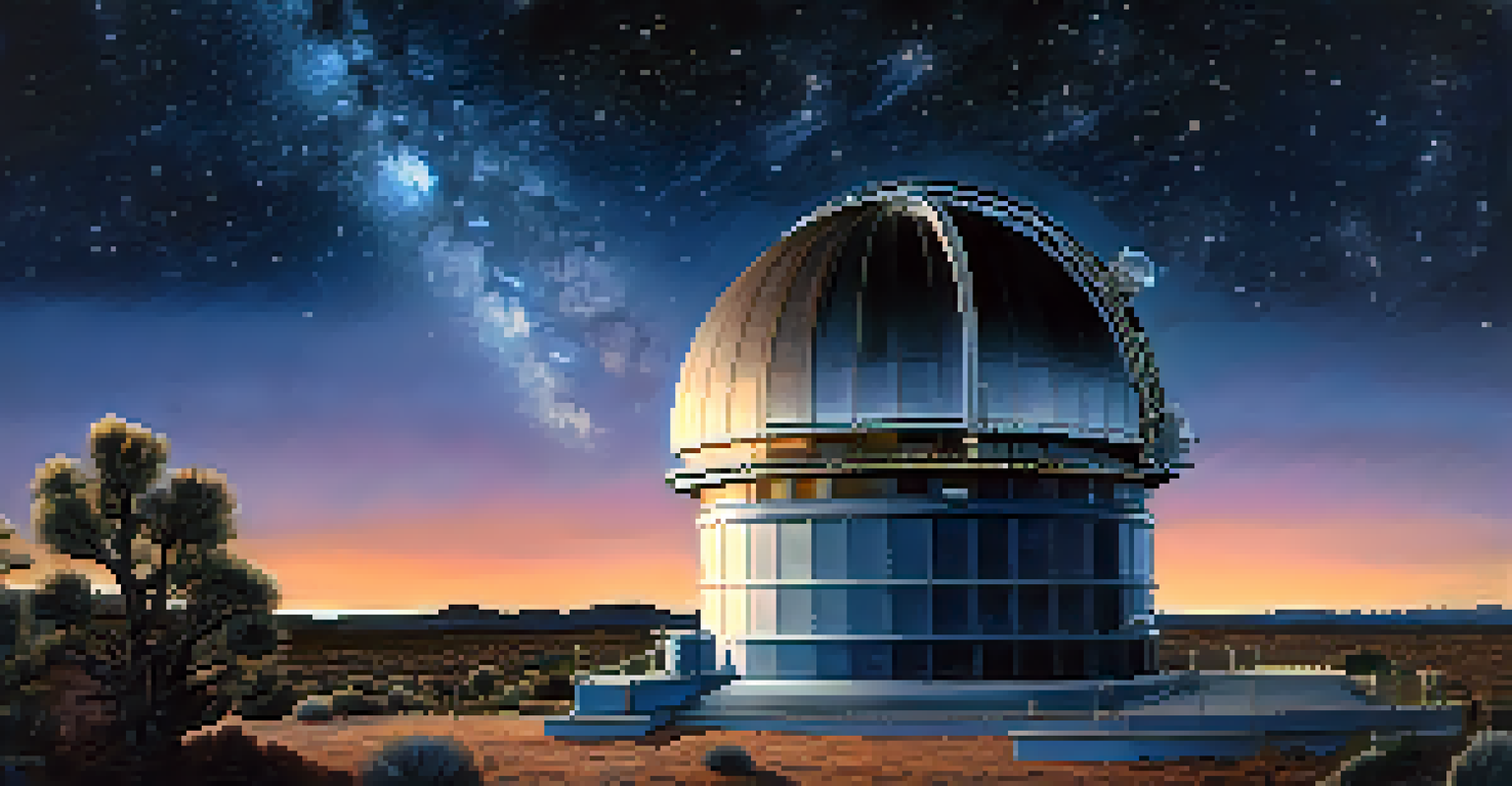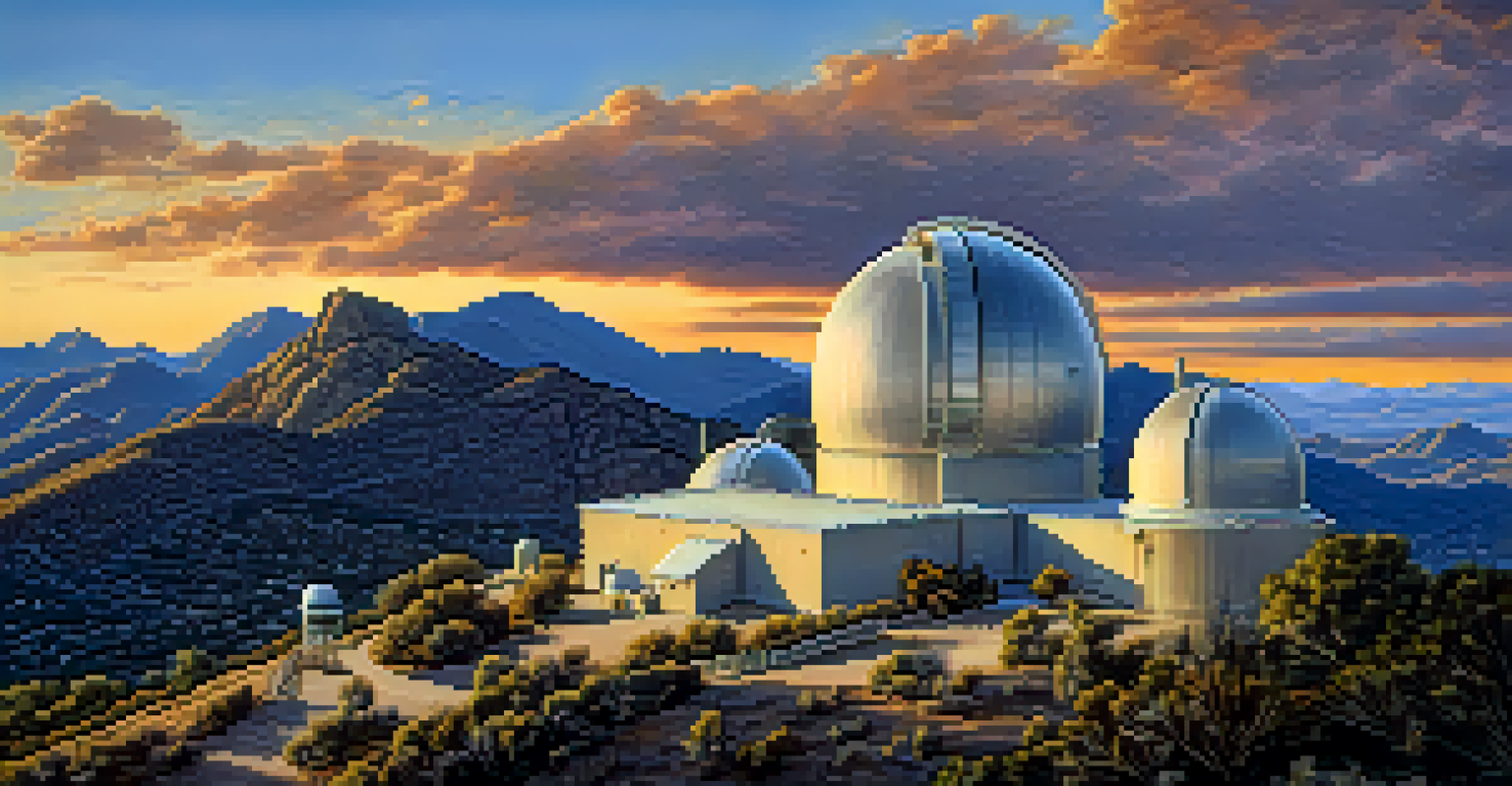The Role of Arizona's Clear Skies in Astronomy Research

Why Arizona's Clear Skies Are Ideal for Astronomy
Arizona is renowned for its exceptionally clear skies, making it a prime location for astronomical research. The state's high elevation and dry climate contribute to minimal atmospheric interference, allowing astronomers to observe celestial objects with unparalleled clarity. This unique combination of factors creates an environment where light pollution is significantly reduced, enhancing the visibility of stars and galaxies.
The cosmos is within us. We are made of star-stuff. We are a way for the universe to know itself.
Many professional observatories, including the famous Kitt Peak National Observatory, are located in Arizona, taking advantage of these perfect conditions. The state's geographical features, such as its mountain ranges and open deserts, provide ideal sites for telescopes. As a result, researchers can conduct detailed studies of the universe without the common hindrances faced in other locations.
Ultimately, Arizona's skies not only attract astronomers from around the globe but also foster advancements in our understanding of the cosmos. The clear conditions allow for longer observation times and more accurate data collection, paving the way for significant discoveries in astronomy.
The Impact of Altitude on Astronomical Observations
The altitude of Arizona's observatories plays a crucial role in enhancing astronomical observations. Higher altitudes mean thinner atmospheres, which reduce atmospheric distortion and provide clearer views of celestial objects. This is particularly important for studying faint objects that require extensive observation time to gather enough light for analysis.

For instance, the Mount Graham International Observatory, situated at an elevation of over 10,000 feet, allows researchers to capture more precise data. The reduced air density at these heights diminishes the atmospheric turbulence that can blur images, allowing astronomers to observe details that would be impossible from lower altitudes.
Clear Skies Enhance Observations
Arizona's exceptionally clear skies and dry climate significantly improve astronomical observations, allowing for detailed studies of celestial objects.
In essence, the combination of altitude and Arizona's clear skies creates a perfect storm for astronomical research, enabling scientists to push the boundaries of what we know about the universe. This unique environment encourages innovation and discovery, making Arizona a leading destination for astronomy.
The Role of Dry Climate in Astronomy
Arizona's dry climate is another factor that significantly benefits astronomical research. With low humidity levels, the atmosphere remains stable, allowing for consistent and reliable observations. Moisture can cause clouds and atmospheric disturbances, which can hinder data collection and analysis.
Astronomy compels the soul to look upward and leads us from this world to another.
The arid conditions in Arizona lead to fewer cloudy nights, meaning astronomers can spend more time observing the night sky. This reliability is invaluable for long-term research projects and for capturing fleeting astronomical events, such as supernovae or transient celestial phenomena.
As a result, the dry climate not only enhances the quality of observations but also maximizes the efficiency of research efforts. This consistency allows scientists to conduct their work without the interruptions that often plague studies in more humid regions.
Light Pollution and Its Effects on Astronomy
Light pollution is a significant concern for astronomers, as it can obscure the visibility of celestial objects. Fortunately, Arizona has implemented measures to minimize light pollution, particularly in areas near observatories. This commitment to preserving dark skies ensures that researchers can conduct their work without interference from artificial lighting.
Areas like the dark sky community of Flagstaff have established strict lighting ordinances to protect the night sky. By reducing unnecessary artificial light, these initiatives help maintain the quality of astronomical observations and allow for a more profound connection to the universe.
Altitude Boosts Research Quality
The high altitude of Arizona's observatories reduces atmospheric distortion, enabling astronomers to capture more precise data from distant celestial phenomena.
Ultimately, these efforts to combat light pollution are crucial for fostering a thriving astronomical research community. With darker skies, astronomers can explore deeper into space, uncovering secrets that would otherwise remain hidden.
Educational Opportunities in Astronomy Research
Arizona's clear skies not only support professional research but also provide valuable educational opportunities for students and enthusiasts alike. Many institutions, like the University of Arizona, offer programs that allow students to work alongside experienced astronomers in world-class facilities. This hands-on experience is vital for fostering the next generation of astronomers.
Public observatories and planetariums across the state also play a pivotal role in education. They offer programs and events that engage the community and allow the public to experience the wonders of the night sky firsthand. These initiatives help ignite a passion for astronomy in individuals of all ages.
By promoting educational opportunities, Arizona nurtures a culture of curiosity and exploration in the field of astronomy. This not only benefits the local community but also enriches the broader scientific landscape, creating a collaborative atmosphere for discovery.
Collaboration Between Institutions for Research
Arizona is home to a network of prestigious institutions that collaborate on astronomical research, pooling resources and expertise. This collaborative spirit enhances the capabilities of each institution, enabling them to tackle complex astronomical questions more effectively. The synergy created by these partnerships leads to groundbreaking discoveries and innovations.
For example, the Arizona Radio Observatory works closely with other institutions to study celestial phenomena through radio waves, complementing traditional optical observations. Such collaborations allow researchers to gain a more comprehensive understanding of the universe by utilizing various methodologies and technologies.
Collaboration Drives Innovations
The collaborative efforts among Arizona's prestigious institutions enhance research capabilities, leading to groundbreaking discoveries in the field of astronomy.
In essence, the collaborative nature of Arizona's astronomical research community strengthens the state's position as a leader in the field. Together, these institutions are pushing the boundaries of our knowledge about the cosmos and inspiring future generations of scientists.
The Future of Astronomy Research in Arizona
Looking ahead, the future of astronomy research in Arizona appears bright, thanks to ongoing investments in technology and infrastructure. New telescopes and observational tools are being developed to explore previously uncharted territories of the universe. Enhanced capabilities will allow astronomers to delve deeper into the mysteries of dark matter, black holes, and the origins of the universe.
Moreover, as the field of astronomy evolves, Arizona is poised to remain at the forefront of innovation. The state continues to attract talented researchers and educators who are passionate about advancing our understanding of the cosmos. This vibrant community fosters creativity and collaboration, paving the way for new discoveries.

In conclusion, Arizona's clear skies, coupled with its commitment to research and education, ensure that the state will remain a vital hub for astronomy for years to come. As we continue to explore the universe, Arizona will undoubtedly play a significant role in unraveling its many mysteries.